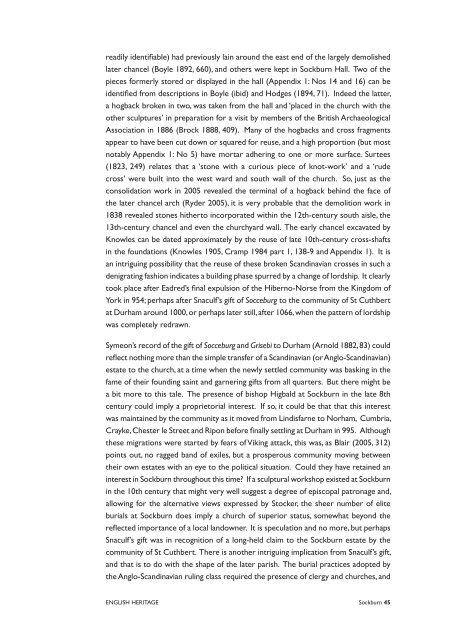Sockburn Hall, Darlington: an archaeological ... - English Heritage
Sockburn Hall, Darlington: an archaeological ... - English Heritage
Sockburn Hall, Darlington: an archaeological ... - English Heritage
Create successful ePaper yourself
Turn your PDF publications into a flip-book with our unique Google optimized e-Paper software.
eadily identifiable) had previously lain around the east end of the largely demolished<br />
later ch<strong>an</strong>cel (Boyle 1892, 660), <strong>an</strong>d others were kept in <strong>Sockburn</strong> <strong>Hall</strong>. Two of the<br />
pieces formerly stored or displayed in the hall (Appendix 1: Nos 14 <strong>an</strong>d 16) c<strong>an</strong> be<br />
identified from descriptions in Boyle (ibid) <strong>an</strong>d Hodges (1894, 71). Indeed the latter,<br />
a hogback broken in two, was taken from the hall <strong>an</strong>d ‘placed in the church with the<br />
other sculptures’ in preparation for a visit by members of the British Archaeological<br />
Association in 1886 (Brock 1888, 409). M<strong>an</strong>y of the hogbacks <strong>an</strong>d cross fragments<br />
appear to have been cut down or squared for reuse, <strong>an</strong>d a high proportion (but most<br />
notably Appendix 1: No 5) have mortar adhering to one or more surface. Surtees<br />
(1823, 249) relates that a ‘stone with a curious piece of knot-work’ <strong>an</strong>d a ‘rude<br />
cross’ were built into the west ward <strong>an</strong>d south wall of the church. So, just as the<br />
consolidation work in 2005 revealed the terminal of a hogback behind the face of<br />
the later ch<strong>an</strong>cel arch (Ryder 2005), it is very probable that the demolition work in<br />
1838 revealed stones hitherto incorporated within the 12th-century south aisle, the<br />
13th-century ch<strong>an</strong>cel <strong>an</strong>d even the churchyard wall. The early ch<strong>an</strong>cel excavated by<br />
Knowles c<strong>an</strong> be dated approximately by the reuse of late 10th-century cross-shafts<br />
in the foundations (Knowles 1905, Cramp 1984 part 1, 138-9 <strong>an</strong>d Appendix 1). It is<br />
<strong>an</strong> intriguing possibility that the reuse of these broken Sc<strong>an</strong>dinavi<strong>an</strong> crosses in such a<br />
denigrating fashion indicates a building phase spurred by a ch<strong>an</strong>ge of lordship. It clearly<br />
took place after Eadred’s final expulsion of the Hiberno-Norse from the Kingdom of<br />
York in 954; perhaps after Snaculf’s gift of Socceburg to the community of St Cuthbert<br />
at Durham around 1000,or perhaps later still,after 1066,when the pattern of lordship<br />
was completely redrawn.<br />
Symeon’s record of the gift of Socceburg <strong>an</strong>d Grisebi to Durham (Arnold 1882,83) could<br />
reflect nothing more th<strong>an</strong> the simple tr<strong>an</strong>sfer of a Sc<strong>an</strong>dinavi<strong>an</strong> (or Anglo-Sc<strong>an</strong>dinavi<strong>an</strong>)<br />
estate to the church, at a time when the newly settled community was basking in the<br />
fame of their founding saint <strong>an</strong>d garnering gifts from all quarters. But there might be<br />
a bit more to this tale. The presence of bishop Higbald at <strong>Sockburn</strong> in the late 8th<br />
century could imply a proprietorial interest. If so, it could be that that this interest<br />
was maintained by the community as it moved from Lindisfarne to Norham, Cumbria,<br />
Crayke, Chester le Street <strong>an</strong>d Ripon before finally settling at Durham in 995. Although<br />
these migrations were started by fears of Viking attack, this was, as Blair (2005, 312)<br />
points out, no ragged b<strong>an</strong>d of exiles, but a prosperous community moving between<br />
their own estates with <strong>an</strong> eye to the political situation. Could they have retained <strong>an</strong><br />
interest in <strong>Sockburn</strong> throughout this time? If a sculptural workshop existed at <strong>Sockburn</strong><br />
in the 10th century that might very well suggest a degree of episcopal patronage <strong>an</strong>d,<br />
allowing for the alternative views expressed by Stocker, the sheer number of elite<br />
burials at <strong>Sockburn</strong> does imply a church of superior status, somewhat beyond the<br />
reflected import<strong>an</strong>ce of a local l<strong>an</strong>downer. It is speculation <strong>an</strong>d no more, but perhaps<br />
Snaculf’s gift was in recognition of a long-held claim to the <strong>Sockburn</strong> estate by the<br />
community of St Cuthbert. There is <strong>an</strong>other intriguing implication from Snaculf’s gift,<br />
<strong>an</strong>d that is to do with the shape of the later parish. The burial practices adopted by<br />
the Anglo-Sc<strong>an</strong>dinavi<strong>an</strong> ruling class required the presence of clergy <strong>an</strong>d churches, <strong>an</strong>d<br />
ENGLISH HERITAGE <strong>Sockburn</strong>

















